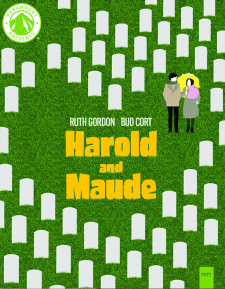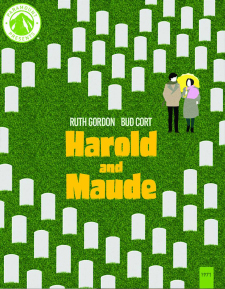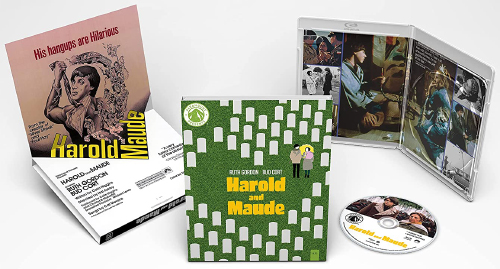Harold and Maude (Blu-ray Review)

Director
Hal AshbyRelease Date(s)
1971 (December 7, 2021)Studio(s)
Paramount Pictures (Paramount Presents #29)- Film/Program Grade: A
- Video Grade: A
- Audio Grade: B
- Extras Grade: B
Review
During the early 1970s, with the Vietnam War still raging and Richard Nixon in the White House, mass protests encountering often violent responses and four student protesters killed and wounded nine at Kent State University by the Ohio National Guard, the youth of America became increasingly alienated from traditional authority and the catchphrase of the era was, “Don’t trust anyone over 30.” Harold and Maude is very much a product of this time yet, paradoxically, its central relationship is between a disaffected young man and a woman long past the age of 30.
Harold Chasen (Bud Cort, McCabe & Mrs. Miller) is a wealthy but morose teenager obsessed with death. He stages elaborate ”suicides” for the benefit of his mother (Vivian Pickles), who is beyond being shocked by his dark antics. He visits cemeteries and attends funerals of people he doesn’t know. His mother sends him first to a psychiatrist, then to his uncle Victor (Charles Tyner), an army general, in the hope that they can straighten him out and put him on an improved path in life, but they fail. Deciding next that what Harold needs is marriage, his mother fills out a dating questionnaire in his name and sets up three dates for him. They don’t go well.
During one of his cemetery visits, Harold notices an elderly woman who also seems to be an observer rather than a relative or friend of the deceased. They later turn up at another funeral together and the woman engages Harold in conversation. She’s Maude (Ruth Gordon, Rosemary’s Baby), a septuagenarian who lives life by her own rules.
Harold becomes fascinated with her. He visits her at home—a converted railroad car overstuffed with fascinating bric-a-brac and artwork. Her eccentricities include driving away with any car that’s handy, speeding on highways, and stealing a cop’s motorcycle. She empathizes so with suffering that she talks Harold into helping her uproot a withering curbside sapling and replanting it in the forest. Maude’s love of life draws Harold out of his shell, and the two share their days watching wrecking balls demolish buildings, visiting cemeteries, and philosophizing about life.
Cort is outstanding in this dark fairytale. Pale and stone-faced in the early scenes, he is an almost spectral vision, going through his days not really living. Cort’s expressions speak volumes as, in one scene, he momentarily breaks the fourth wall to smile wickedly into the camera before turning to his disapproving mother, that smile quickly changing to a somber countenance. Once Harold meets Maude, Cort takes on a healthier look. There’s color in his face and he smiles more. He seems enchanted with this elderly woman who acts like a kid.
Gordon often chews up the scenery but conveys an offbeat charm that’s hard to resist. We can’t quite get a handle on Maude, and Colin Higgins’ script keeps her somewhat enigmatic. A brief glimpse of a tattoo gives the character gravity, making her not a loony-old-lady caricature but a woman who’s not had the easiest life. Gordon is a mischievous elf next to rail-thin, long-limbed, gawky Cort.
Vivian Pickles gives Harold’s mother a resigned yet frustrated demeanor. She simply doesn’t know why her son is so odd or how to cope with him, and repeatedly makes plans for him that backfire. Pickles’ deadpan delivery of the first line in the film, after seeing Harold hanging by the neck, sets the tone for her character: “I suppose you think that’s very funny.”
Director Hal Ashby has assembled a funny, sentimental, dark comedy. Cat Stevens’ music is a vital ingredient that underscores the tone of the film and is a perfect fit. Stevens wrote two new songs for the picture, including the film’s main theme, If You Want to Sing Out, Sing Out.
Harold and Maude was shot by director of photography John A. Alonzo on 35 mm film with Arriflex 35 IIC and Panavision PSR cameras, finished photochemically at Technicolor laboratories, and presented in the widescreen aspect ratio of 1.85:1. The Paramount Presents line offers up the film with a new 4K scan of the original camera negative, a definite step up from the 2013 Criterion Collection Blu-ray release, which was sourced from a 2K scan of an interpositive. Clarity and contrast on this restored and remastered Blu-ray are very good. Details, such as the wrinkles in Ruth Gordon’s face, the eclectic clutter in Maude’s railroad car home, patterns in Vivian Pickles’ costumes, and military bars and insignia on Harold’s uncle’s uniform are clearly delineated. Complexions are natural, with the exception of Harold’s pallor in the early scenes that gives way to a more natural look after he meets Maude. Color palette is diverse, ranging from browns, blacks, and grays in some scenes and more vibrant hues in a daisy field, the grassy expanse of a cemetery, roses atop a coffin, and Maude’s bright, cheery dresses. There are no noticeable imperfections in the print such as scratches, dirt specks, or emulsion clouding.
The soundtrack is English 5.1 Dolby True HD. Other options are German and French 2.0 Mono Dolby Digital. Available subtitles include English, English SDH, German, and French. Dialogue is sharp and clear throughout. Gordon speaks rapidly in many scenes but her dialogue is precisely delivered. There isn’t much sound movement despite the stereo track, with most of the sound focused on the front channel. There are several speeding car scenes, but there’s minimal sense of sound movement from speaker to speaker. Director Hal Ashby amusingly incorporates the sound of marching and shouted orders whenever Harold’s uncle, an army general, is on screen. Sound effects include screeching cars, demolition noise, a gun shot, a blazing fire, and a marching band. Stevens’ music is the heartbeat of the film.
The 29th release in the Paramount Presents series, the Blu-ray disc of Harold and Maude sits in a clear amaray case with double-sided artwork, featuring new artwork on the front and stills accompanied by a quote from the film on the reverse. Everything is housed within a slipcover that folds out to reveal the film’s original poster art. A Digital code is included in the packaging.
Bonus materials include the following:
- Audio Commentary with Larry Karazewski and Cameron Crowe
- Yusef/Cat Stevens on Harold and Maude (5:48)
- Theatrical Trailer #1 (3:03)
- Theatrical Trailer #2 (3:03)
Larry Karaszewski and Cameron Crowe begin their commentary by stating that neither of them has anything to do with the film. They simply love it and consider it one of the “all-time greats.” Cat Stevens gave director Hal Ashby two demos of songs that hadn’t been put on albums and said he’d re-record them if Ashby liked them. Ashby loved the songs and he put the demos into the film as is. John Rubinstein was originally considered for the role of Harold. When Bud Cort came in for his audition, he declared, “I am Harold.” Different compositions by director of photography John A. Alonzo are discussed. Without music, the film plays like a “lugubrious drama.” The songs reflect the emotion of the scenes and enliven the film, giving it a whimsical quality. A stunt woman did the driving for Ruth Gordon, who didn’t know how to drive. Director Ashby visually juxtaposes life and death images. The original reviews for the film were negative. Variety said, “Harold and Maude has all the gaiety of a burning orphanage.” Though it did well in some cities, it didn’t make money or catch on until 1974, when it was re-released and did very well. The ending makes the film a “sparkling gem.”
Yusef/Cat Stevens loved the story, seeing some of himself in Harold. The songs then became integral to the story. The soundtrack consisted of Stevens’ existing songs and two new ones. Ruth Gordon sang, on an out-of-tune piano, If You Want to Sign Out, Sing Out. Stevens thought it was awful but director Hal Ashby loved Gordon’s rendition and kept it in. Stevens had no input as to how his songs were used.
Not carried over from the now out-of-print Criterion Blu-ray are the film’s original mono and stereo remix audio tracks, an audio commentary with Hal Ashby biographer Nick Dawson and producer Charles B. Mulvehill, an audio interview with director Hal Ashby from a 1972 American Film Institute seminar, an audio interview with writer/producer Colin Higgins from a 1979 American Film Institute seminar, a Seeing Songs: Yusuf/Cat Stevens and Harold and Maude interview from 2011, and various materials from that release’s insert booklet. Also not carried over from the Region B Eureka! Blu-ray release is the Questions and Answers 2014 interview with critic David Cairns, and various materials from that release’s insert booklet as well.
Harold and Maude is a darkly comic tale with an embedded serious theme running throughout. Harold’s faked suicides and the reactions of his dates are inspired comic high points. The film’s life-affirming attitude is rooted in Maude’s not-so-pleasant past, and its joyous spirit is infectious. Cort and Gordon have great screen chemistry in an unconventional, sweet buddy film.
- Dennis Seuling


